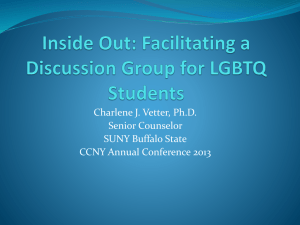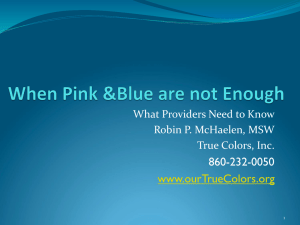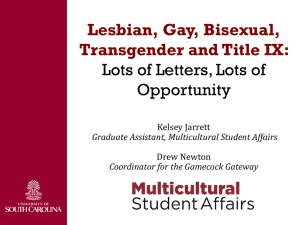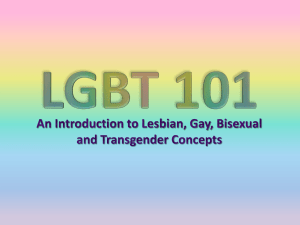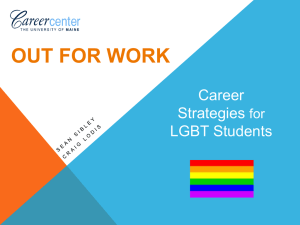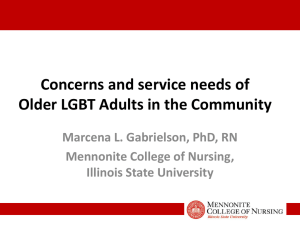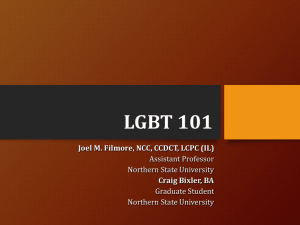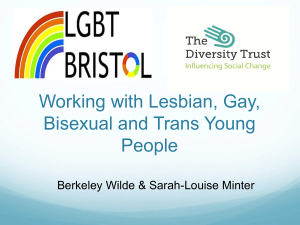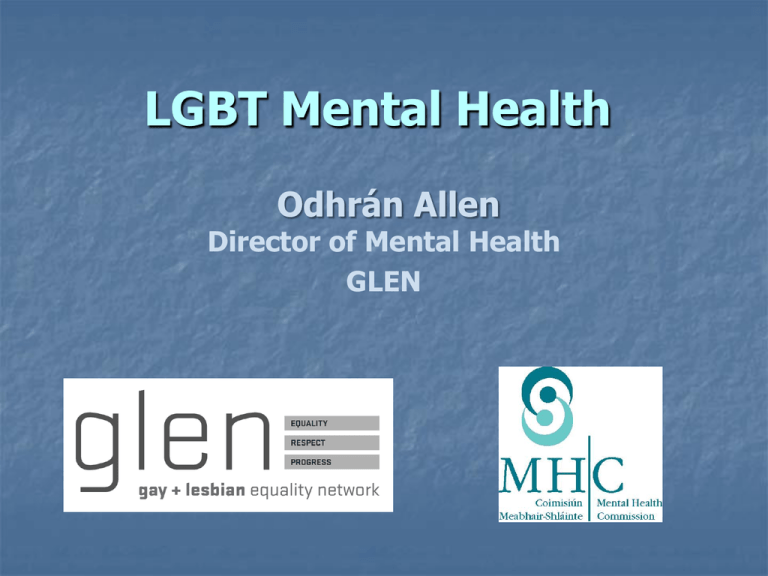
LGBT Mental Health
Odhrán Allen
Director of Mental Health
GLEN
Sexuality
Four components:
Biological sex
Social gender role
Sexual orientation
Gender identity
(American Psychological Association, 2008)
Sexual Orientation
Sexual orientation is distinguished by an
emotional, romantic, sexual or affectionate
attraction to individuals of a particular sex.
(APA, 2008)
Sexual Orientation
Three sexual orientations:
Heterosexual = attraction to individuals
of the opposite sex
Homosexual = attraction to individuals
of one’s own sex
Bisexual = attraction to members of both
sexes
LGB = Lesbian, Gay & Bisexual
Lesbian woman = a woman who is
romantically, sexually and emotionally
attracted to women
Gay man = a man who is romantically,
sexually and emotionally attracted to men
Bisexual = a man or woman who is
romantically, sexually and emotionally
attracted to someone of either sex
Avoid using homosexual to refer to someone
8% LGB in My World Survey (2012)
Gender Identity
Gender identity refers to whether one
feels male or female regardless of sex
assigned at birth.
Gender expression refers to outwardly
expressing one’s gender identity through
mannerisms, grooming, physical
characteristics, social interactions and
speech
(American Psychological Association)
Transgender
Transgender is a term used to describe
people whose gender identity or gender
expression, differ from the sex assigned to
them at birth
Not everyone whose feelings, appearance
or behaviour is gender-atypical will
identify as a transgender person
Gender dysphoria – gender identity
opposite to sex assigned at birth
(Transsexual, GID)
Gender Dysphoria
Transgender Girl/Woman
Designated male sex
Male appearance
Raised as a boy
Identifies as a girl/woman
Trans girl/woman or
woman with trans history
(GIRES, 2013)
Transgender Boy/Man
Designated female sex
Female appearance
Raised as a girl
Identifies as a boy/man
Trans boy/man or man
with a trans history
Transitioning
Process of changing the way someone’s gender
is lived publicly. People who wish to transition
often start by expressing their gender identity in
situations where they feel safe.
Typically work up to living full-time in their
preferred gender by making gradual changes to
their gender expression.
Transitioning typically involves changes in
clothing and grooming, a name change, change
of gender on identity documents, hormonal
treatment and surgery.
(American Psychological Association)
Transitioning
Psychosocial support during process
Connecting with other transgender people
through peer support groups and transgender
community organisations is also very helpful for
people when they are going through the
transition process.
Professional guidelines: www.wpath.org
Information & support:
TENI = Transgender Equality Network Ireland www.teni.ie
TransParentCI – Trans Parent Connect Ireland via TENI
LOOK (Parent Support) www.lovingouroutkids.org
BeLonG To Youth Service www.belongto.org
Demographics
First major Irish study on LGBT mental health
Commissioned: GLEN & BeLonG To Youth Service
Funded: HSE National Office for Suicide Prevention
Research Team: TCD & UCD - Paula Mayock, Audrey
Bryan , Nicola Carr, Karl Kitching
1,110 survey participants and 40 interviewees
Age range: 14 – 73
LGB: 96%, T: 4%
Mental health: Key Findings
46% had hazardous drinking (AUDIT-C)
27% had self-harmed at least once
85% more than once
16 years = average start age
40% female and 20% male
17.7% had attempted suicide at least once
60% more than once
17.5 = average start age
24% female and 15% male
⅓ of under 25s had seriously contemplated suicide
in past year (50% ever)
These findings strongly linked with LGBT-specific
stresses. i.e. minority stress
Minority Stress: 3 Characteristics
1. Unique – additional to general stressors that
are experienced by all people. Members of
minority groups require a stress adaptation
effort above that required of non-minorities
2. Chronic – related to enduring underlying social
and cultural structures
3. Socially Based – stems from social processes,
institutions and structures beyond the individual
(Meyer, 2003)
COMING OUT
Realising LGBT identity:
12 years of age = most common age
Disclosing LGBT identity:
17 years of age = most common age
5 year period between people knowing they
were LGBT and disclosing this to others.
This period of time coincided with participant’s
school-going years – a time of critical social and
emotional development
Emerged as a time of particular vulnerability
“Coming out is probably one of the most
extreme and difficult things you can do. Before
you come out you have to deal with it all
yourself and it took me six years to. And I
couldn’t be myself for those six years and it is,
again, it’s called in the closet because you are in
the closet. No one can see you; they see this
door because no one’s ever opened up the
closet to look inside”
COMING OUT
Coming out was more positive than anticipated
for majority of respondents
Majority came out to a friend or other trusted
individual prior to coming out to their family.
Feelings of relief were commonly felt after coming
out, particularly when respondents received a
positive response from others.
Regardless of outcome of coming out, the period
prior to coming out was consistently reported
as a stressful one – questioning identity, afraid to
tell parents/friends, secret crush on best friend,
being seen as different, worries about future life
For some their distress wasn’t eased by coming out
HARASSMENT
HARASSMENT in daily life:
80% had been verbally abused because of
their LGBT identity
40% were threatened with physical
violence
25% had been punched, kicked or beaten
“I’m sure people knew I was gay you
know, I’d walk up through the village and
people would be calling faggot and stuff
like that. It did kill me a lot hearing the
words and stuff and I was afraid as well. I
felt very alone inside and the drink was
my best friend”
HOMOPHOBIA IN SCHOOLS
58% reported homophobic bullying in their school
40% verbally threatened by fellow students
25% physically threatened by fellow students
20% missed or skipped school because they felt
threatened or were afraid of getting hurt at school
34% reported homophobic comments by teachers
8% were called homophobic names by teachers
5% left school early because of homophobic
bullying
“I left school because of the hurt and suffering I
got in school, and the teachers didn’t care, as I
think it was a case of "well they call him gay and
he probably is gay, so why should we step in,
cos they aren’t saying anything wrong" attitude
towards gay people... even though I wasn’t out
at school. I was forced to leave at my junior
cert, due to the abuse I got … jumped on,
called puff, queer etc”
SUICIDALITY/SELF-HARM linked to:
Younger age
Victimisation experiences
Fear of rejection or actual rejection by family
& friends
Homophobic bullying in school
Higher alcohol consumption
Key Findings Comparison: LGB & T
Lesbian, Gay, Bisexual
Now comfortable: 81%
Physically attacked: 24.4%
Contemplated suicide: 26%
Self-harm: 27%
Attempted suicide: 17.7%
Transgender
Now comfortable: 61%
Physically attacked: 39.1%
Contemplated suicide: 80%
Self-harm: 43.5%
Attempted suicide: 26.1%
“My mother doesn’t get my body yet and
she was very shocked at first. She tried to
convince herself that it was just a phase
and then she was trying to tell me that
there are some women who are feeling
masculine but they are fine with it. When I
told her I was actually going through
hormone therapy, she was like, if you’re
doing that then you’re not living here
anymore” (Female-to-Male Trans, 20).
SOCIAL SOURCES OF
RESILIENCE
1.
2.
3.
4.
Supportive friends
Accepting family
Belonging to LGBT community group or
organisation
Positive school or work experiences
PERSONAL SOURCES OF
RESILIENCE
1.
2.
3.
4.
Forming a positive LGBT identity
Developing good self-esteem
Positive turning points
Developing positive coping strategies
“I am happy to conclude by saying that I
am now a very content, confident, welladjusted gay man, fully out and very
happy to be gay. I have grown and
thrived with the love and support of my
friends and two of my sisters … being gay
was never my problem but how people
reacted to me being gay was certainly part
of what made life very hard in the past”
Available at: http://www.glen.ie/newspost.aspx?contentid=15493&name=new_l
gbt_guide_for_mental_health_services
Thank you
odhran@glen.ie
@odhranallen
www.glen.ie
Other Information
& Resources
INCLUSIVE PRACTICE
Inclusive practice means:
Expecting diversity among your clients,
colleagues, service users, etc. and respecting
this diversity.
Understanding the issues facing diverse groups
(such as LGBT people) and being able to
respond to their specific needs.
Providing an accessible and appropriate service
within your area of competence.
(Psychological Society of Ireland, 2008)
UNHELPFUL SERVICES
Unhelpful services had 5 characteristics:
Presumption of heterosexuality
Lack of understanding of LGBT issues
A lack of meaningful connection between
the person and the practitioner
A lack of willingness or ability on the part of
the practitioner to engage with or respond
to LGBT people’s specific concerns or needs
Anti-LGBT bias among professionals
(Mayock et al 2009)
HELPFUL SERVICES
Helpful Services had 4 characteristics:
Acceptance and open-mindedness of
practitioners towards the LGBT people
Unbiased, sensitive practice
The provision of constructive and
meaningful support
Confidence of the LGBT person that they
were understood by the professional
(Mayock et al 2009)
General Guidelines
Adapted from Lesbian, Gay and Bisexual Patients:
The Issues for Mental Health Practice (2010)
Be aware of LGBT mental health issues/LGBT-specific
stressors and assess for/respond to same
2.
Don’t assume everyone is heterosexual/not
transgender
3.
Respond supportively when service users disclose
they are LGBT
4.
Challenge anti-LGBT bias if it exists and take a ‘gayaffirmative’ approach (see CPsychI Guide & APA)
5.
Demonstrate that your practice is inclusive of LGBT
people
(see guide for more detail on these)
1.
Professional Anti-Gay Bias
Professional anti-gay bias results in lesbian, gay and
bisexual people receiving sub-optimal care and
experiencing direct or indirect discrimination or exclusion
when they use health services. The characteristics of
professional anti-gay bias are:
Presuming service users are heterosexual
Pathologising, stereotyping and stigmatising LGB service
users
Failing to empathise with or recognise LGB service users‟
health concerns
Denigrating any non-heterosexual form of behaviour,
identity, relationship, family or community
Attempts to change a person’s sexual orientation
(Irish Institute of Mental Health Nursing, 2010)
Reparative Therapy
As the name suggests, reparative (or conversion) therapy
is based on the belief that homosexuality is an illness and
aims to cure LGB people by converting them to
heterosexuality.
Extensive empirical research has been carried out on the
use of reparative therapy with LGB people and this
research has demonstrated that reparative therapy does
not work and can be damaging to the mental health of LGB
people who undergo it.
The CPsychI, ICGP, IASW and IIMHN do not support
referral to or the practice of reparative therapy or any
approach aiming to change a person’s sexual orientation
and instead promote inclusive practice that is gayaffirmative.
Gay-affirmative approach
A gay-affirmative approach is based on the
following key principles derived from research:
Same-sex sexual attractions, behaviour, and orientations
per se are normal and positive variants of human
sexuality and are not indicators of either mental or
developmental disorders
Lesbians, gay men, and bisexual people can live
satisfying lives and form stable, committed relationships
and families that are equivalent to heterosexuals’
relationships and families in essential respects
Same-sex sexual orientation is not linked to family
background, problems or trauma
Sexual orientation cannot be changed and attempts to
change a person’s sexual orientation do not work and
can be damaging to the mental health of those who
undergo it
The historical stigmatisation of lesbian, gay and bisexual
people can have a variety of negative consequences
throughout the life span for LGB people and social
workers need to be proactive in challenging this
stigmatisation among professional peers, society and
service users.
(Irish Association of Social Workers, 2011)
Resources for Professionals:
Sexual Orientation
Lesbian, Gay & Bisexual Patients: The Issues for Mental Health Practice
College of Psychiatry of Ireland, 2011.
Available at:
www.glen.ie/attachments/CPsychI_LGB_Mental_Health_Guide.PDF
Gay, Lesbian &Bisexual People: Guide to Good Practice for Mental Health Nurses
Irish Institute of Mental Health Nursing, 2010. Available at:
www.glen.ie/attachments/IIMHN_LGB_Mental_Health_Guide.PDF
Lesbian, Gay & Bisexual People: A Guide to Good Practice for Social Workers
Irish Association of Social Workers, 2011.
Available at:
www.glen.ie/attachments/IASW_LGB_Mental_Health_Guide.PDF
Appropriate Therapeutic Responses to Sexual Orientation
American Psychological Association, 2009.
Available at:
www.glen.ie/attachments/APA_Therapeutic_Responses.PDF
Resources for Professionals:
Gender Identity
Standards of Care for the Health of Transsexual, Transgender and Gender
Nonconforming People
The World Professional Association for Transgender Health, 2012. Available at:
www.glen.ie/attachments/WPATHstandards.PDF
Guidance for GPs, Other Clinicians and Health Professionals on the Care of
Gender Variant People: Transgender Wellbeing and Healthcare
National Health Service, 2008.
Available at:
www.gires.org.uk/assets/DOH-Assets/pdf/doh-guidelines-for-clinicians.pdf
GIRES: Gender Identity Research and Education Society
www.gires.org.uk/index.php
Irish LGBT Reports
LGBT Health: Towards Meeting the Healthcare Needs of Lesbian, Gay,
Bisexual and Transgender People
Health Service Executive, 2009.
Available at:
www.glen.ie/attachments/HSE_LGBT_Health_Report.PDF
Supporting LGBT Lives: A Study of the Mental Health and Wellbeing of
Lesbian, Gay, Bisexual and Transgender People
Mayock, Bryan, Carr & Kitching, 2009.
Available at:
www.glen.ie/attachments/Supporting_LGBT_Lives_Report.PDF
Visible Lives: Identifying the Experiences and Needs of Older Lesbian, Gay,
Bisexual and Transgender people in Ireland
Higgins, Sharek, McCann, Sheerin, Glacken, Breen & McCarron, 2011. Available at:
www.glen.ie/attachments/Visible_Lives_Report.PDF


